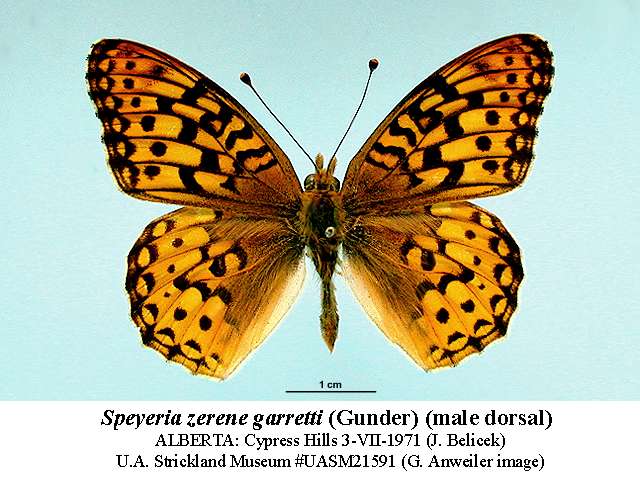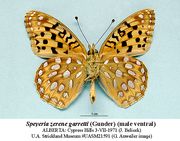Species Details
Speyeria zerene
University of Alberta E.H. Strickland Entomological Museum Read more about this collection »
Common NameZerene Fritillary
SeasonalityOne yearly flight, peaking from mid July to mid August.
IdentificationA somewhat variable species that can hard to distinguish from S. egleis and S. edwardsii. The ground colour of the hindwing underside is reddish brown, while egleis and edwardsii generally have an overall darker, more greenish hindwing, with a poorly defined submarginal pale band. The upperside of Zerene also has smaller dark markings than Egleis. Subspecies garretti inhabits Alberta.
Scientific Name
Speyeria zerene
Common Name
Zerene Fritillary
Habitat
Prefers fescue grasslands of the southern mountains and foothills.
Seasonality
One yearly flight, peaking from mid July to mid August.
Identification
A somewhat variable species that can hard to distinguish from S. egleis and S. edwardsii. The ground colour of the hindwing underside is reddish brown, while egleis and edwardsii generally have an overall darker, more…
A somewhat variable species that can hard to distinguish from S. egleis and S. edwardsii. The ground colour of the hindwing underside is reddish brown, while egleis and edwardsii generally have an overall darker, more greenish hindwing, with a poorly defined submarginal pale band. The upperside of Zerene also has smaller dark markings than Egleis. Subspecies garretti inhabits Alberta.
Life History
Unknown in Alberta. The pink-tan eggs are laid near violets (Scott 1986), and mature larvae vary from orange-brown to grey to black, but generally with a lateral stripe (Layberry et al. 1998), and possess an eversible…
Unknown in Alberta. The pink-tan eggs are laid near violets (Scott 1986), and mature larvae vary from orange-brown to grey to black, but generally with a lateral stripe (Layberry et al. 1998), and possess an eversible gland on the thorax which emits a musky smell, a possible anti-predator mechanism (McCorkle in Scott 1986). Larvae, like those of most other Speyeria, have spine-bearing protubernaces (Guppy & Shepard 2001). Females are able to delay egg laying until the cooler, moister conditions of late summer prevail (Scott 1986, Guppy & Shepard 2001). Subspecies hippolyta, the Oregon Silverspot, is threatened in the US, and ssp. bremneri (Bremner's Fritillary) is of special concern in BC (Guppy & Shepard 2001).
Conservation
Alberta populations are not of concern.
Diet Info
The larval hosts are not known in Alberta, but probably include one or more species of violet as in BC (Hardy 1958). Adults take nectar at gaillardia and thistles (Hooper 1973).
Range
Southern BC to Cypress Hills, SK south to CA and CO. North along the Pacific coast to southern AK (Layberry et al. 1998, Guppy & Shepard 2001).
References
Author
Bird, C. D., G.J. Hilchie, N.G. Kondla, E.M. Pike and F. A. H. Sperling
Title
Alberta Butterflies
Publication Date
1995
Pages
349
Author
Guppy, Crispin S. and Jon H. Shepard
Title
Butterflies of British Columbia.
Publication Date
2001
Pages
414
Author
Hardy, G. A.
Title
Notes on the life histories of three species of Lepidoptera from southern Vancouver Island, British Coloumbia.
Publication Date
1958
Series Title
Proceedings of the Entomological Society of British Columbia
Volume
55
Pages
27-30
Author
Layberry, Ross A.; Hall, Peter W. and J. Donald LaFontaine
Title
The Butterflies of Canada
Publication Date
1998
Pages
280
Author
Scott, J. A.
Title
The Butterflies of North America : a natural history and field guide
Publication Date
1986
Pages
583 pp.
Author
Hooper, R.R.
Title
The Butterflies of Saskatchewan
Publication Date
1973
Pages
216 pp.
Specimen Information
There are 9 specimens of this Species.
UASM33626 - Speyeria zerene
University of Alberta E.H. Strickland Entomological Museum
Place CollectedCanada: Alberta, Table Mountain
Collected ByLawrie, D.
Date Collected1995-08-05
UASM33627 - Speyeria zerene
University of Alberta E.H. Strickland Entomological Museum
Place CollectedCanada: Alberta, Mount Allan
Collected ByLawrie, D.
Date Collected1984-07-14
UASM33628 - Speyeria zerene
University of Alberta E.H. Strickland Entomological Museum
Place CollectedCanada: Alberta, Table Mountain
Collected ByLawrie, D.
Date Collected1995-08-05
UASM33629 - Speyeria zerene
University of Alberta E.H. Strickland Entomological Museum
Place CollectedCanada: Alberta, Longview
Collected ByLawrie, D.
Date Collected1992-06-27
UASM211730 - Speyeria zerene
University of Alberta E.H. Strickland Entomological Museum
Place CollectedCanada: Alberta, Kananaskis Country, Moose Mountain
Collected ByAnderson, R. L.
Date Collected1987-07-14
UASM211731 - Speyeria zerene
University of Alberta E.H. Strickland Entomological Museum
Place CollectedCanada: Alberta, Kananaskis Country, Moose Mountain
Collected ByAnderson, R. L.
Date Collected1987-07-14
UASM211732 - Speyeria zerene
University of Alberta E.H. Strickland Entomological Museum
Place CollectedCanada: Alberta, Kananaskis Country, Moose Mountain
Collected ByAnderson, R. L.
Date Collected1987-07-14
UASM211733 - Speyeria zerene
University of Alberta E.H. Strickland Entomological Museum
Place CollectedCanada: Alberta, Kananaskis Country, Moose Mountain
Collected ByAnderson, R. L.
Date Collected1987-07-14
UASM211734 - Speyeria zerene
University of Alberta E.H. Strickland Entomological Museum
Place CollectedCanada: Alberta, Kananaskis Country, Moose Mountain
Collected ByAnderson, R. L.
Date Collected1987-07-14



